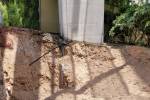One true sentence says it all
Ernest Hemingway once said, “The writer’s job is to tell the truth.” I do not consider myself a writer per se, but nonetheless, I believe he is right.
The truth, as one can best determine it, is powerful. It is not always pleasant or welcome but it beats a pack of lies any day.
Writing about green living is no different. The topic is broad. There are enough tips, techniques and resources to provide fodder for a lifetime of columns. But for me, echoing the latest news about weather-stripping or low-E windows is not enough.
The truth about green living lies in the fundamentals: understanding our impact on the world and learning how to live in balance with it. I want to influence hearts, not hardware stores.
I have been privileged to write this column and share ideas with a broader audience, but as television anchor Edward R. Murrow said, “Just because your voice reaches halfway around the world doesn’t mean you are wiser than when it reached only to the end of the bar.”
No one has all the answers or knows for certain what the future holds, but there are some increasingly well-informed scenarios. The best we can do is to tell the truth, especially about things that matter most. It is not as easy as it seems.
Another great line from Hemingway comes to mind: “All you have to do is write one true sentence. Write the truest sentence you know.”
Here is mine: Life on Earth is at serious risk and we are responsible for it.
There you go. That’s my truth. Over eight years of green living columns have been written with the intent to help change that. My truth is grounded in direct observation and experience.
Science, along with plenty of people much smarter than I am, informs with details. What I am learning breaks my heart.
Human beings have had so much going for us. Perhaps too much. We have become victims of our own success, if you can call it that.
Our sheer numbers and rate of consumption have done it. Our economic system insanely demands incessant growth.
Combined, they have taken us far beyond anything that can be sustained much longer on this beautiful and finite planet. Indeed, the signs are everywhere.
Like Wile E. Coyote who ran beyond the edge of the cliff, we are in overshoot. All that remains is for us to realize it.
Being printed in the Your Home section, this column has mostly focused on ways to make our homes more efficient, more in alignment with limits already exceeded; but clearly green living requires much more from us if we care about consequences.
During a recent guest appearance on KNPR’s “State of Nevada,” I was asked about the possibility of human extinction. After providing my take on it, another guest, meteorologist and Slate writer Eric Holthaus said, “We’re causing the rapid extinction of other species. If I was a coast redwood or one of the endangered species on the planet, I would be pretty pissed at humans right now.” Holthaus seemed to think humans are exempt.
Around 200 species go extinct each day, a rate much higher than the historical norm and nothing less than a holocaust. Therefore we are living on an increasingly lifeless planet. How long will we live in denial about the consequences of our choices?
How long before we pass a point where no action, no matter how drastic or expensive, will be able to avert this most dire of outcomes? I think we are close. Perhaps we have passed it already.
I’m not willing to make that assumption yet.
In my mind, these are questions we should not even consider. Rather, we should do everything we possibly can to live on the planet as if we intend to stay.
Business as usual is no longer an option. We have squandered “usual.” At this point, it will take a level of commitment and action beyond “a man on the moon in 10 years.” After all is said and done, nothing else really matters.
Steve Rypka is a green living consultant and president of GreenDream Enterprises, a company committed to helping people live lighter on the planet. For more information and links to additional resources relating to this column, or to reach Rypka, visit www.greendream.biz.























